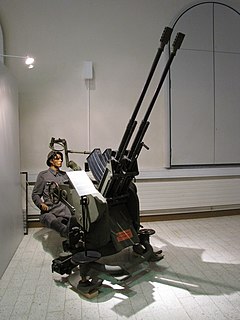 W
WThe 20 ItK 40 VKT or 20 mm dual anti-aircraft cannon model 1940 manufactured by VKT was a Finnish light anti-aircraft gun designed by the Finnish gunsmith Aimo Lahti. As the only multi-barrel 20 mm anti-aircraft gun 20 ItK 40 VKT was the most effective 20 mm air defence weapon used by the Finnish Army during World War II. A total of 174 guns were built, used in training until the 1970s and kept in reserve until 1988. The gun received the nickname Vekotin (gadget) from Finnish soldiers. The nickname was reached by adding to the abbreviation of manufacturer, VKT.
 W
W37-mm trench gun M1915 was a Russian battalion gun employed in World War I.
 W
WThe 57 55 J or 57 mm, 55 caliber length model Jokinen coastal gun is a Finnish light coastal gun designed during the Continuation War. It the first coastal gun designed and manufactured completely in Finland and was intended to replace the older 57 mm Nordenfelt and Hotchkiss guns, but the design was found faulty and only 11 pieces were constructed. They were used for training after World War II until retired in the mid–1960s.
 W
WThe Ehrhardt 7.5 cm Model 1901 was a field gun designed and built by the German company Rheinische Metallwaren- und Maschinenfabrik and sold to Norway in 1901. It remained the main field artillery gun of the Norwegian Army until the German invasion of Norway in 1940. The Germans impressed the surviving guns and used them in Norway for the duration of the Second World War. They equipped German units in Norway and were used as coastal artillery guns; a number were even modified for use as anti-tank guns. A dozen guns were transferred by the Norwegian government to Finland during the Winter War and were used by them during the Continuation War as well.
 W
WThe 75 mm gun model of 1917 was an interim measure, based on the British QF 18-pounder, produced by the United States in World War I after it had decided to switch from 3-inch (76 mm) to 75 mm calibre for its field guns.
 W
WThe French 75 mm field gun was a quick-firing field artillery piece adopted in March 1898. Its official French designation was: Matériel de 75mm Mle 1897. It was commonly known as the French 75, simply the 75 and Soixante-Quinze. The French 75 was designed as an anti-personnel weapon system for delivering large volumes of time-fused shrapnel shells on enemy troops advancing in the open. After 1915 and the onset of trench warfare, other types of battlefield missions demanding impact-detonated high-explosive shells prevailed. By 1918 the 75s became the main agents of delivery for toxic gas shells. The 75s also became widely used as truck mounted anti-aircraft artillery. They were also the main armament of the Saint-Chamond tank in 1918.
 W
WThe Type 31 75 mm quick-firing gun was the main field gun deployed by the Imperial Japanese Army in the Russo-Japanese War of 1904–1905.
 W
WThe 76 mm gun model 1900, also called 76 mm Putilov M1900 gun, was a light quick-firing field gun of the Imperial Russian Army used in the Russo-Japanese War, World War I, Russian Civil War and a number of interwar armed conflicts with participants from the former Russian Empire.
 W
WThe 76.2 mm divisional gun model 1902 was a Russian light field gun used in the Russo-Japanese War, World War I, Russian Civil War and a number of interwar armed conflicts with participants from the former Russian Empire. Modernized versions of this gun were employed at the early stage of World War II.
 W
W76 mm divisional gun M1902/30 was a Soviet modernized version of the Russian World War I 76 mm divisional gun M1902, employed in the early stages of Operation Barbarossa.
 W
WThe 76-mm divisional gun M1936 (F-22) was a Soviet divisional semi-universal gun, adopted for Red Army service in 1936. This gun was used in conflicts between the USSR and Japan on the Far East, in the Winter War and in World War II. Many F-22s were captured by the Wehrmacht, modernized by the Germans and used against Soviet forces.
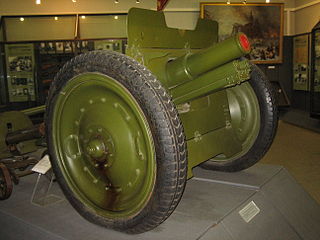 W
WThe 76 mm regimental gun M1927 was a Soviet infantry support gun. The gun was developed in 1927 by the design bureau of Orudiyno-Arsenalny Trest (OAT) and entered production in 1928. A total of 18,116 pieces were built. On June 22, 1941, the Red Army had 4,708 of these guns. In 1943 the gun was replaced in production by the 76 mm regimental gun M1943, but remained in service until the end of the war. The Germans placed captured guns into service as the 7.62 cm Infanteriekanonehaubitze 290(r), while in the Finnish army they were known as 76 RK/27.
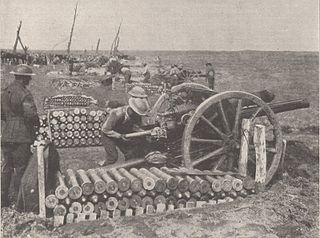 W
WThe Ordnance QF 18-pounder, or simply 18-pounder gun, was the standard British Empire field gun of the First World War-era. It formed the backbone of the Royal Field Artillery during the war, and was produced in large numbers. It was used by British Forces in all the main theatres, and by British troops in Russia in 1919. Its calibre (84 mm) and shell weight were greater than those of the equivalent field guns in French (75 mm) and German (77 mm) service. It was generally horse drawn until mechanisation in the 1930s.
 W
W87-mm light field gun M1877 was a field gun utilized in Russo-Japanese War, World War I, Russian Civil War and a number of interwar period armed conflicts with participants from the former Russian Empire. The gun was initially developed by Krupp, but was also produced in the Russian Empire. Russian-manufactured pieces differed from the German-manufactured ones in breech type and construction elevation mechanism. The gun lacked recoil mechanism.
 W
WThe de Bange 90 mm cannon was a type of field artillery piece developed in France by Colonel Charles Ragon de Bange in 1877, and adopted by the French Army that same year. It superseded the earlier Reffye cannon (1870/73) and the Lahitolle 95 mm cannon (1875).
 W
W100 56 TK or 100 TK is a Finnish stationary coastal artillery gun that utilizes the tank turret from the Soviet T-55 tank with its 100 mm D-10 tank gun. 100 56 TK was the main light weapon of the Finnish coastal artillery and complemented the medium gun 130 TK in the coastal artillery role until its decommissioning in 2012.
 W
WThe 10.5 cm leFH 18 is a German light howitzer used in World War II and the standard artillery piece of the Wehrmacht, adopted for service in 1935 and used by all divisions and artillery battalions. From 1935 to the end of the war, 11,848 were produced, along with 10,265 of the leFH 18/40 variant.
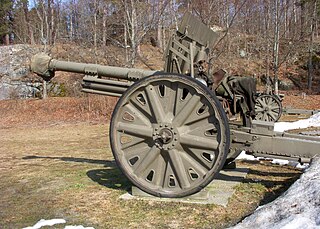 W
WThe 10,5 cm Haubits m/40 is a Swedish 105 mm howitzer, which was manufactured by Bofors during World War II.
 W
WThe Canon de 105 mle 1913 Schneider was a French artillery piece used in World War I and World War II by many European countries.
 W
WThe 10.5 cm kanon m/34 was a heavy field gun produced in Sweden.
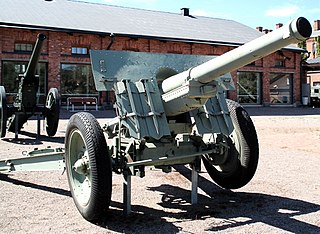 W
WThe 105 mm Armata wz. 29 was a field gun produced in France and Poland that was used by Poland, Nazi Germany, and Finland during World War II.
 W
W107-mm gun model 1910 was a Russian field gun developed in the years before the First World War. It also saw service during the Russian Civil War, Winter War and Second World War. The gun was initially developed and produced by the French arms manufacturer Schneider, but was later built by the Putilovski and Obukhov plants in Saint Petersburg.
 W
W42-line fortress and siege gun M1877 was a siege gun used by the Russian Imperial Army in late 19th and early 20th centuries. The word "line" in the designation refers to a measurement unit which equals 0.1 inch. Curiously, the "model year" was not the year when the weapon was designed or standardized, but the year when a new rifling system was adopted.
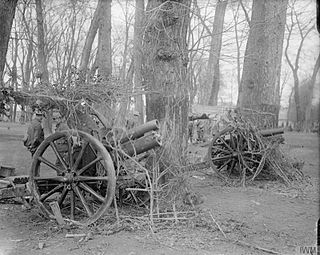 W
WThe Ordnance QF 4.5-inch howitzer was the standard British Empire field howitzer of the First World War era. It replaced the BL 5-inch howitzer and equipped some 25% of the field artillery. It entered service in 1910 and remained in service through the interwar period and was last used in the field by British forces in early 1942. It was generally horse drawn until mechanisation in the 1930s.
 W
W122 mm howitzer M1909/37 was a Soviet 121.92 mm (4.8 inch) howitzer, a modernization of World War I era 122 mm howitzer M1909. The gun saw combat in the German-Soviet War.
 W
W122 mm howitzer M1909/37 was a Soviet 121.92 mm (4.8 inch) howitzer, a modernization of World War I era 122 mm howitzer M1909. The gun saw combat in the German-Soviet War.
 W
W122 mm howitzer M1910/30 was a Soviet 121.92 mm (4.8 inch) howitzer, a modernization of World War I era 122 mm howitzer M1910. It was the most numerous divisional howitzer of the RKKA at the outbreak of Great Patriotic War and remained in service throughout the war.
 W
W122 mm howitzer M1910/30 was a Soviet 121.92 mm (4.8 inch) howitzer, a modernization of World War I era 122 mm howitzer M1910. It was the most numerous divisional howitzer of the RKKA at the outbreak of Great Patriotic War and remained in service throughout the war.
 W
W122 mm corps gun M1931/37 (A-19) was a Soviet field gun developed in late 1930s by combining the barrel of the 122 mm gun M1931 (A-19) and the carriage of the 152 mm howitzer-gun M1937 (ML-20). The gun was in production from 1939 until 1946. It saw action in World War II and remained in service for a long time after the end of the war. Vehicle-mounted variants of the gun were fitted to the IS-2 and IS-3 tanks of the Iosif Stalin series of tanks and the ISU-122 self-propelled gun.
 W
WThe BM-21 "Grad" is a Soviet truck-mounted 122 mm multiple rocket launcher. The weapons system and the M-21OF rocket were first developed in the early 1960s, and saw their first combat use in March 1969 during the Sino-Soviet border conflict. BM stands for boyevaya mashina, and the nickname grad means "hail". The complete system with the BM-21 launch vehicle and the M-21OF rocket is designated as the M-21 field-rocket system. The complete system is more commonly known as a Grad multiple rocket launcher system. In NATO countries the system was initially known as M1964. Several other countries have copied the Grad or have developed similar systems.
 W
W130 53 TK or 130 TK is a Finnish fixed, heavy artillery piece, manufactured by Tampella. The caliber is 130 mm. The 130 53 TK is the main weapon of the Finnish coastal artillery.
 W
WThe 130 mm towed field gun M-46 is a manually loaded, towed 130 mm artillery piece, manufactured in the Soviet Union in the 1950s. It was first observed by the west in 1954.
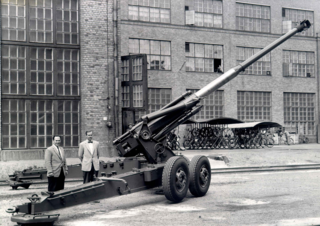 W
WThe 130 K 90-60 is a Finnish towed 130 mm coastal artillery piece, manufactured in the 1980s by Vammas.
 W
WThe Type 38 15 cm Howitzer was a 1905 German design that was purchased by the Empire of Japan as the standard heavy howitzer of the Imperial Japanese Army at the end of the Russo-Japanese War. The Type 38 designation was given to this gun as it was accepted in the 38th year of Emperor Meiji's reign (1905).
 W
WThe 15 cm schwere Feldhaubitze M. 15 was a heavy howitzer used by Austria-Hungary in World War I. Austrian and Czech guns were taken into Wehrmacht service after the Anschluss and the occupation of Czechoslovakia as the 15 cm schwere Feldhaubitze 15(t) or (ö).
 W
WThe 15 cm schwere Feldhaubitze 18 or sFH 18, nicknamed Immergrün ("Evergreen"), was the basic German division-level heavy howitzer during the Second World War, serving alongside the smaller but more numerous 10.5 cm leFH 18. Its mobility and firing range and the effectiveness of its 44 kilogram shell made it the most important weapon of all German infantry divisions. A total of 6,756 examples were produced.
 W
WThe 15 cm Nebelwerfer 41 was a German multiple rocket launcher used in the Second World War. It served with units of the Nebeltruppen, German Chemical Corps units that had the responsibility for poison gas and smoke weapons that were also used to deliver high-explosives during the war. The name Nebelwerfer is best translated as "smoke mortar".
 W
W152 mm howitzer M1909/30 was a Soviet 152.4 mm howitzer, a modernization of the 152 mm howitzer M1909, initially designed by Schneider. It was the most numerous 152 mm howitzer employed by Red Army in World War II.
 W
WThe 152 mm howitzer Model 1910 Schneider or, more properly, 6 dm polevaja gaubitsa sistemy Schneidera as it was designated in Tsarist times, was a French howitzer designed by Schneider et Cie. It was used by the Russian Empire and the Soviet Union during World War I, the Russo-Polish War and the Russian Civil War. Finland captured nine during the Finnish Civil War, but did not use them during that conflict. They did see combat during the Winter War and the Continuation War.
 W
WThe 152 mm howitzer-gun M1937 (ML-20), is a Soviet heavy gun-howitzer. The gun was developed by the design bureau of the plant no 172, headed by F. F. Petrov, as a deep upgrade of the 152-mm gun M1910/34, in turn based on the 152-mm siege gun M1910, a pre-World War I design by Schneider. It was in production from 1937 to 1946. The ML-20 saw action in World War II, mainly as a corps / army level artillery piece of the Soviet Army. Captured guns were employed by Wehrmacht and the Finnish Army. Post World War II, the ML-20 saw combat in numerous conflicts during the mid to late twentieth century.
 W
W152-mm howitzer M1938 (M-10) was a Soviet 152.4 mm howitzer of World War II era. It was developed in 1937–1938 at the Motovilikha Mechanical Plant by a team headed by F. F. Petrov. Although production of the gun was stopped in 1941, it saw combat with the Red Army until the end of World War II and remained in service until the 1950s. Captured pieces were used by Wehrmacht and the Finnish Army. The latter kept the M-10 in service until 2000.
 W
WThe 152 mm gun-howitzer M1955, also known as the D-20, is a manually loaded, towed 152 mm artillery piece, manufactured in the Soviet Union during the 1950s. It was first observed by the west in 1955, at which time it was designated the M1955. Its GRAU index is 52-P-546.
 W
W152 H 88 is the name of a series of modernized 152 mm towed heavy howitzers with 32 caliber barrels. The guns of the series share the same barrel as well as other similar qualities, but differ slightly in appearance, since they consist of three different, older (modernized) versions. The modernization was carried out by Vammas Oy from 1988 to mid-1990s. The modernization project consisted of numerous modifications to the guns, some of which had already undergone earlier smaller modifications. The most important change was the replacement of the original barrels by a Finnish-made 152 mm barrel. Also the gun carriages were subjected to various modifications. After the modernization, increased towing speeds were made possible. The breech mechanism is manually operated in all the guns. All the 152 H 88 series artillery pieces are being withdrawn from service and scrapped.
 W
W152 H 88 is the name of a series of modernized 152 mm towed heavy howitzers with 32 caliber barrels. The guns of the series share the same barrel as well as other similar qualities, but differ slightly in appearance, since they consist of three different, older (modernized) versions. The modernization was carried out by Vammas Oy from 1988 to mid-1990s. The modernization project consisted of numerous modifications to the guns, some of which had already undergone earlier smaller modifications. The most important change was the replacement of the original barrels by a Finnish-made 152 mm barrel. Also the gun carriages were subjected to various modifications. After the modernization, increased towing speeds were made possible. The breech mechanism is manually operated in all the guns. All the 152 H 88 series artillery pieces are being withdrawn from service and scrapped.
 W
W6-inch siege gun model 1904 was a Russian 152.4 mm heavy siege gun. It was produced by Perm Works, with a total of about 200 pieces having been built.
 W
WThe 6-inch siege gun model 1877 was a Russian 152.4 mm (6 in) fortress gun, siege gun and coastal defense gun. It was used in the Russo-Japanese War, World War I, and the Russian Civil War. The successor states of the Russian Empire also inherited a number of M1877 guns.
 W
WThe Canon de 155 C modèle 1915 Saint-Chamond was a French howitzer used during World War I. It was based on a private prototype of a 150 millimetres (5.9 in) howitzer presented to the Mexican government in 1911. The French government ordered 400 Saint-Chamond howitzers in 1915, these being delivered starting in late 1916. Small numbers of Saint-Chamond howitzers were given to the Serbian and Romanian armies towards the end of World War I. The Saint-Chamond howitzer served in the French Army after World War I and were mobilised at the outbreak of World War II. Finland bought 24 Saint-Chamond howitzers during the Winter War and these served until the 1960s. The German Army captured some Saint-Chamond howitzers after the fall of France and used these mostly as coastal defence guns until the end of World War II.
 W
WThe Canon de 155 C modèle 1917 Schneider, often abbreviated as the C17S, was a French howitzer designed by Schneider. It was essentially the Canon de 155 C modèle 1915 Schneider fitted with a different breech to use bagged propellant rather than the cartridge cases used by the older howitzer. It was used by France, Russian Empire, Belgium, Rumania, and the United States from 1917 during World War I and was widely exported after the war. Surviving weapons were in service with France, Poland, Greece, Italy, Belgium, the United States, and Finland during World War II. Captured weapons were used by the Germans for their 2nd-line artillery and coast defense units.
 W
WThe 155 GH 52 APU, Finnish designation 155 K 98, is a Finnish towed artillery piece developed in 1998. It is largely based on the 155 K 83 with some major enhancements. It can be moved on the field short distances with its own auxiliary diesel engine, which is used in all 56 units used by the Finnish defence forces, is a 78-kilowatt Deutz diesel engine. The Egyptian units are not equipped with the APU.
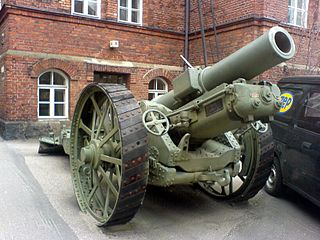 W
WThe BL 8-inch howitzer Marks VI, VII and VIII were a series of British artillery siege howitzers on mobile carriages of a new design introduced in World War I. They were designed by Vickers in Britain and produced by all four British artillery manufacturers, but mainly by Armstrong, and one American company. They were the equivalents of the German 21 cm Morser 16 and in British service were used similarly to the BL 9.2-inch howitzer, but were quicker to manufacture, and more mobile. They delivered a 200 lb (91 kg) shell to 12,300 yards (11.2 km). They had limited service in the British Army in World War II before being converted to the new 7.2-inch (180 mm) calibre. They also equipped a small number of Australian and Canadian batteries in World War I and by the US Army in that war. They were used in small numbers by other European armies.
 W
WThe 21 cm Mörser 16, or 21 cm Lange Mörser M 16/L14.5, was a heavy howitzer used by Germany in World War I and World War II.
 W
WThe Tampella 155 K 83 is a Finnish towed 155 mm field gun, manufactured in the 1980s by Tampella.
 W
WThe ZU-23-2, also known as ZU-23, is a Soviet towed 23 mm anti-aircraft twin-barreled autocannon. ZU stands for Zenitnaya Ustanovka – anti-aircraft mount. The GRAU index is 2A13.